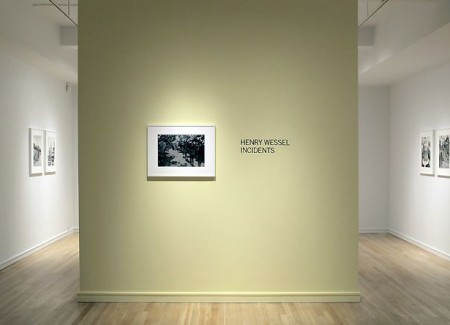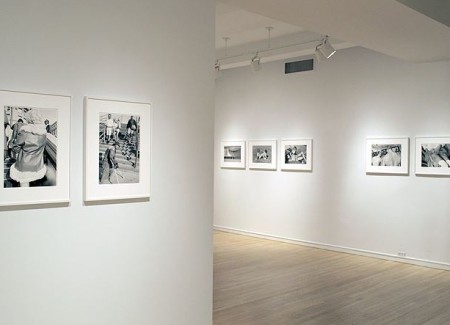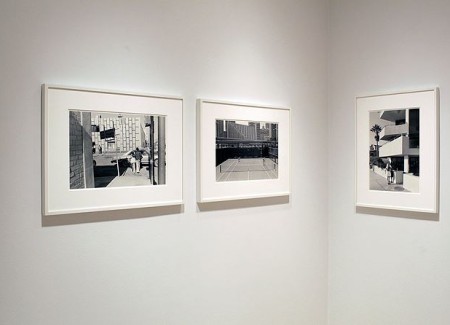JTF (just the facts): A total of 27 black and white photographs, framed in white and matted, and hung against yellow and white walls in the main rooms of the gallery. All of the photographs are modern gelatin silver prints, made from undated negatives. Each of the images is sized 12×18 (or reverse) and the prints are uneditioned. There is no photography allowed in the gallery, so the installation shots at right are via the Pace/MacGill website.
Comments/Context: In an art market that actively celebrates the power of the single, wall-dominating artwork, the carefully sequenced series of photographs that functions together as an integrated whole has slowly become something unexpected. While we are of course used to common subjects gathered together in photographic projects, true edited sequences have generally been relegated to books, limited edition portfolios and other special circumstances. Henry Wessel’s new show bucks this prevailing tide, bringing together a selection of unrelated images and placing them in exacting order, creating a kind of visual rhythm not unlike a poem. While each “incident” can stand alone, when seen together, they connect into an elegant linear flow of motifs and ideas.
The first photograph in the series is a kind of invitation, an encouraging participatory gesture to follow the trail of people walking into the park. Soon we encounter a dog, and then observe a man watching the world go by from a bus bench, puzzlingly wearing soccer cleats with his everyday attire. We spin around from his perspective and watch cars go by – dinged doors, angled stoplights, and a station wagon full of kids catching our attention. In a flash, we are inside those same cars, looking out through dark framed windows at boys choking each other or men in suits walking near whitewashed low rise apartments. We get off at a bus top, and back on the street, we notice the shine of a fur collared coat and the squiggled shadow of a stairway railing, only to be further distracted by a series of geometries seen in sidewalk paving, privacy walls, brickwork, and jutting balconies. Shadows and natural greenery pull us onward, only to be interrupted by more rigid man-made lines of fences and window frames. We start to notice the patterns in doorways as we walk along, drawn into scalloped edges, window portholes, and dense horizontal blinds. A topless theater entrance leads to a couple in front of an abandoned stage, and pairs of people bring the wandering journey to a close, with interlocked legs, expansive backs, and a final thigh bruise to put a period on the impressionistic narrative.
While I didn’t resonate with every image in Wessel’s parade of California bright street photography, I was fascinated by the visual hand-offs that were occurring between each picture and its neighbors; there really is a smart connection at every transition. As such, I was less focused on whether any single photograph had been optimized for success, and more on how the whole package had been so perfectly assembled. This show is like an old string of Christmas lights that won’t work unless every bulb is plugged in; each individual light is lively and exciting, but they only really dazzle when they’re all tied together in exacting order.
Collector’s POV: The photographs in this show are priced at $3300 each. Wessel’s prints have been intermittently available in the secondary markets in recent years, with prices ranging from roughly $3000 to $16000.









Well, you missed the mark on this review, and seems like you spent time talking to someone at the gallery about the work instead of really looking.
Every image in this show is well executed, and can stand on its own as a great photograph.
What makes the work exceptional is the fact the Wessel is one of the greatest editors of his generation.
If you know anything of Wessel's work then there is a clear shift here from light hearted humorous works to something much darker.
What you see as “car pictures” is a sequence starting with a guy with a cigarette in one hand and coffee in the other, making driving impossible. Then a family of five looking out the car window at what must be horrific based on there expressions. This followed by the viewer looking through the car window at a child violently choking another kid. These connections are just the tip of the iceberg of what is happening in this show. These dark themes, great photographs, and sequencing makes this a 3 star show.
Stop spending so much time trying to write water downed reviews, and start really looking at the medium you suggest you actually like.
Wow, anonymous, you might want to cut back on your coffee intake. It's making you irritable.
The blogger was very respectful, imho, of Wessel's work and intent but was making a different point. He is correct that it is rare to see a truly well-sequenced show that is not an obvious “series” and was celebrating that fact. What's wrong w/ that?